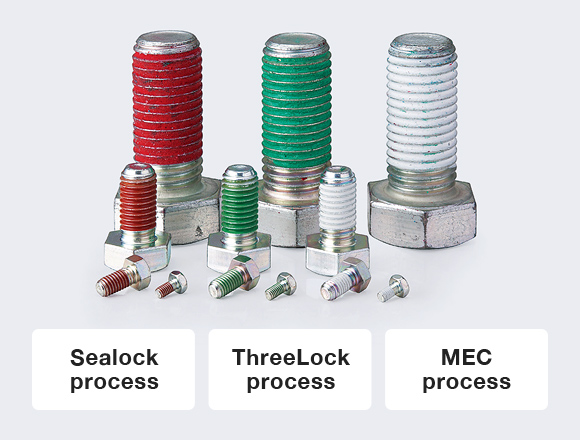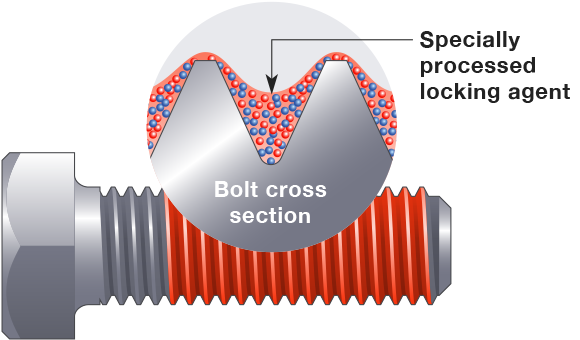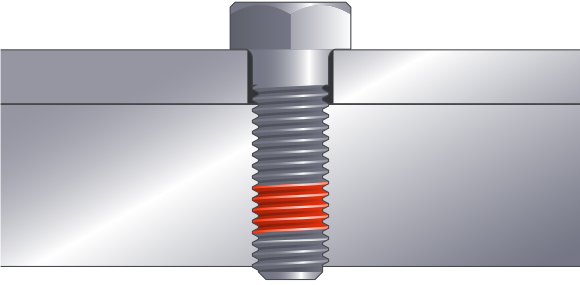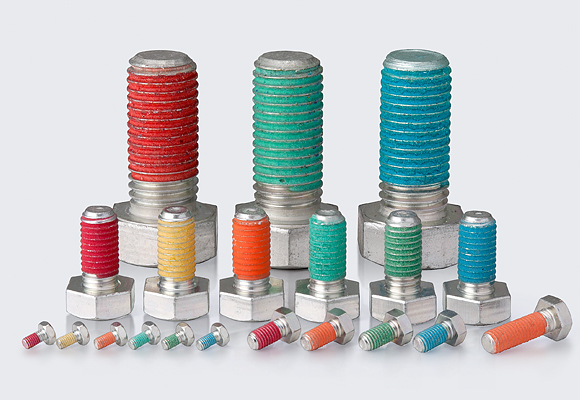No.6
Precoat process for bolts
Features
This process allows the bolt itself to provide excellent locking and sealing.

- By applying reactive resin, synthetic resin, etc. to the threaded parts of bolts, screws, etc. in advance, it is possible to impart functions such as sticking, sealing, and lubricity.
- Functions can be demonstrated simply by assembling bolts, screws, etc.
- The use of adhesive can be omitted on the production line.
- Pre-coated bolts can be selected according to the application
How to use
How to use pre-coated bolts
Bolts and screws are pre-coated with resin, so each function can be achieved simply by assembling.
Types of pre-coated bolts
ThreeBond has three types of pre-coated bolts.
MEC process
MEC process is a processing technology in which a microcapsule compound containing an adhesive is specially applied to the threads of screws to provide sealing and locking functionality.

Reaction initiates by tightening a screw
- MEC-processed screws are coated with a dry resin film. When screwed in, their microcapsule breaks and the contained locking ingredients seep out, causing a curing reaction.
- The screw, lock agent, and sealant are integrated, and an excellent effect can be achieved simply by tightening the screw.
ThreeLock process

- This is a processing technology specializing in non-reactive locks, in which a nylon resin is melted and adhered to bolt threads to add an anti-loosing effect to them.
- It applies the properties of nylon resin to improve the bolt fastening function, exhibiting excellent effects.
Sealock process
- This is a processing technology specializing in non-reactive sealing, in which acrylic resin or fluorine resin is melted and adhered to the threads of bolts to provide lubrication and sealing properties to the bolt itself.
- It's not sticky, so it won't stain your hands, clothes, or work area.
Uses
Application examples of MEC process

- Securing various screws of power tools
- Prevention of oil leakage from engine plugs
- Securing various screws of electrical components
- Various types of loosening prevention for general home appliances and electrical appliances
Application examples of ThreeLock process
- Preventing small screws used in mobile phones and laptop PCs from dropping
- Preventing small screws used in car navigation systems and car audio systems from loosening
- Preventing small screws used in eyeglasses and various bolts from loosening
Application examples of Sealock process
- Prevention of leakage from pipe joints (processing on pipe threads)
FAQ
-
Q
Can I use it repeatedly even after using it once?
-
A
Non-reactive ThreeLock process products can be used repeatedly.
-
Q
Do I need protective equipment?
-
A
When using a reactive MEC-processed product, please use protective equipment such as gloves.
For MEC-processed products, adhesive oozes out of the microcapsules when bolts are used, so if it comes into contact with the skin or mucous membranes, you may get a rash.
Non-reactive Sealock-processed products and ThreeLock-processed products do not require special protective equipment.
-
Q
Is it possible to apply the process to items other than screws/bolts?
-
A
ThreeBond also utilizes the process for nuts in addition to screws/bolts.
Please contact us to inquire about applying the process to other workpieces and parts.
Precautions for use
-
Usage for special purposes such as medical and food-grade manufacturing
Our products are developed for general industrial use. We have not confirmed the safety of use for medical or food-grade manufacturing. Always carry out a preliminary test suitable for the application to confirm safety before use.
Never use in medical implant products. -
Incorrect usage
In the following cases, the adhesive strength and sealing properties will not be fully realized.- Foreign matter (moisture, oil, solvent, dust, etc.) has contaminated the threaded part.
- Tightening is poor (overtightening, undertightening).
- Clearance (gap) is too large.
- Insufficient curing time after tightening.
- The temperature during and after tightening is too low.
- Pre-coated bolts (MEC-processed products, Sealock-processed products) that have been used once are reused.
-
Material composition of the other item
Some plastics may deteriorate when they come into contact with the adhesive, so check in advance for any effects (cracking, melting, swelling, whitening, etc.). -
Adhesion and removal of "residue"
-
If you want to remove precoating agent on your clothing
If the residue comes from tightening, it can be easily removed with a cloth or with air. However, if the residue is rubbed by hand, the precoating agent will get in between the clothing fibers, making it difficult to remove. -
When you want to remove precoating agent on a workpiece
Blow off the residue with air. Some residues contain adhesive and become moist due to the crushing of microcapsules. They will harden over time and cannot be removed by blowing with air. In this case, wiping with a solvent (thinner) is effective. If the residue remains firmly even after wiping it off, it has cured and needs to be physically peeled off.
-
If you want to remove precoating agent on your clothing
Click here for "Handling of Pre-coated Bolts,"
a booklet of precautions for handling pre-coated bolts.
Summary
The precoat process for bolts is a processing technology in which screws or bolts themselves provide excellent sealing and locking ability. It is a very environmentally-friendly technology that has been increasingly demanded in the market, and greatly reduces costs as well.
At ThreeBond, we strive to create products that best meet your design requirements.
